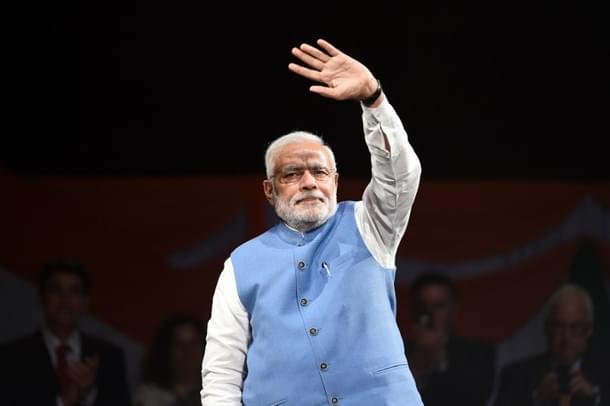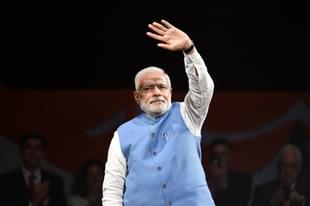Politics
We Want A Deng Out Of Modi
Gautam Mukherjee
May 31, 2015, 12:03 PM | Updated Feb 11, 2016, 09:47 AM IST
Save & read from anywhere!
Bookmark stories for easy access on any device or the Swarajya app.


Now that the first, foundational year of the Narendra Modi government is over, what is the task ahead? Is the economy, which must enable and drive the desire for vikas and transformation at a tipping point yet? But what does this mean, what level suffices?
Is the economy fulfilling its promise when it grows from a low of 4.4 per cent of GDP, at its nadir under the UPA, to a near-time zenith of 7.4 per cent this year, and on to almost double digits over the remaining four years? Is too much being made of the tag of having the fastest growth rate in the world today, when the rate itself, and indeed, the present overall size of the economy, is vastly inadequate to address our needs?
Is this 7.4 per cent headed towards 9 per cent of GDP, rosy as it sounds, enough to match the very grand ambitions projected for India? No, actually we need a much more explosive growth engine, the brute of a sports car as opposed to an elegant sedan that must rocket ahead in double digits for the next two to three decades. Then, and only then, given our gargantuan population and rate of population growth, can we become a notable developed country, and decisively eliminate at least the most grinding poverty.
Another modest inflection point of sorts, a beginning, may indeed have arrived already, as we may see a soaring take-off in infrastructure and manufacturing projects in Year 2. This will be fuelled by billions of dollars in foreign investment, coaxed out of 18 foreign state visits made by Prime Minister Modi in Year 1. But will Modi’s far less energetic Government be able to iron out the wrinkles as promised — and in time — to receive such intended largesse?
The present pattern of incrementalism and gradualism is simply not good enough, except in comparison to a catatonic UPA between 2010 and 2013. It is at great variance to the bold promises routinely made by Modi that make us expect a lot more.
For a government with a historic majority not seen in 30 years, it has been dithering and unsure in practice, over cautious, diffident, and slow on every front, even as it hesitantly grapples with a tumultuous opposition in Parliament — an opposition that should have remained thoroughly demoralised if the Modi government had hit the ground running.
The question is not whether this government is making steady progress, as the one-year celebrations are at pains to point out; but what great systemic changes can Narendra Modi bring about, because he has not done much on this front so far.
Not a lot, that is, beyond easing the logjam somewhat, and passing some key and long pending legislations, conducting some well-run auctions of national resources and getting things moving on the defence preparedness front. This is better than predecessor Manmohan Singh and the UPA, of course, but that is not saying very much.
Modi has, after all, systematically and wilfully fired the imagination of this nation of 125 crore of people, but where is the daring expected from him administratively, except in a few infrequent but characteristic flashes?
The loyal voting public that still gives him a minimum approval rating of over 60 per cent in recent opinion polls believes ‘NaMo’ is a tall leader, a man of destiny, much taller than his party and RSS backers, raised to the top job to realise India’s true potential at last. The voting public, that third of the polity on average that is the solid Modi supporter, instinctively feels he can lead this country into an unprecedented renaissance, comparable only with Bharat’s legendary past. This lot is impatient with democratic processes, and wants swift action to deliver prosperity and jobs.
But for this to come about, Modi has to show his true colours, assuming them to be that of a committed free-marketeer. The former dynamic chief minister of Gujarat seems to be somewhat lost in South Block and Race Course Road, and his team of cabinet colleagues appear to be inadequate in their tasks, thoroughly dominated by the bureaucracy of an ancien regime.
Modi’s own supposedly clear-cut and mercantile touch is missing from his governance across the board, all except for his personally superb handling of foreign affairs. In this, in a very short time, he has raised India’s profile around the globe as a place ready to do business and grow for mutual benefit. And this, without the constraints and ideological timidity of the past!
If this were a totalitarian system like China’s, Modi could perhaps have rammed his vision through, as Deng Xiaoping in his time did, giving China three decades of over 10 per cent growth that continued year on year well after Deng’s death. President Xi Jinping of the present tense might be able to do the same too, despite the dictates and greater complexity of changed circumstances, and a very different geopolitical scenario.
But in a vibrant democracy like India’s, the undertow of the past, particularly rich with the emotional rhetoric of a long running socialist script, the way forward can only come with an abrupt turn.
What Modi must do when he finds the political courage, is become a Kemal Ataturk-style figure. He must engineer a veritable lurch to the right. A turn that is so profound, as to catch the entire political class by surprise and leave them scurrying to catch up to the brave new world of possibilities he opens up.
Instead, the opposition today has once again grown comfortable in mining its old shibboleths, its rhetorical accusations, hollow though they are, of a “suit-boot ki sarkar”, working only for its rich cronies, while the corrupt and disgraced Congress shamelessly affects to bleed afresh for the poor and the under-privileged!
The rump of a Congress presence has revived because of a mysterious hesitation in the Modi government. Why is this? Is it afraid of being anything other than centrist with a tinge of the Left based on political calculations for important assembly elections coming up shortly? But will this wolf in sheep’s clothing act help it in Bihar and beyond?
Perhaps the hesitation is doing more harm than good, as the Modi sarkar is looking lost and uncannily like the UPA extended, without, that is, the corruption and the paralysis. It needs to make dramatic moves however, because that is why it was elected, and attempting to be too much of all things to all people will not help its cause.
There must be drastic changes made in order to deliver second-stage structural reforms. Changes such as booting out the multi-layered taxation regime, gutting it to match the lowest levels of taxation in the developed world — and that too in one fell swoop. Cutting interest rates not at the rate of a pathetic 25 basis points at a time, but lowering it dramatically to 4 per cent or lower at one go, right now. Not dithering on the side of a sterile caution that has served to only leave us behind, but making the rupee fully convertible this year.
The government needs to eliminate restrictive labour laws in their entirety and let market forces prevail. This will signal the arrival of a bold and confident new India to the foreign investor and encourage it to take the plunge. Doing away with the concept of land acquisition and ‘land use’ as such, and buying land at market rates instead, based on demand and supply. Avoiding protectionism wherever possible. Cutting all subsidies and letting global commerce make up the difference.
Moves such as these, made en masse, will mean such a profound departure from present practice that there will be no way back to the socialism of yore. This, just as there has been no going back after the first stage reforms of 1991.
But even as things stand, the Land Bill, despite the lightning and thunder it has provoked as a flash in the pan, will pass in Parliament very soon. So will GST and every other piece of legislation this Government proposes in future. This is because of the NDA’s combined strength in both the Houses in a joint sitting, enough to give it a comfortable majority, as long as it carries its own flock.
In addition, the fact that it is working on both the AIADMK under a reinstated Chief Minister Jayalalithaa and the TMC under Mamata Banerjee is also of considerable significance going forward. And the Modi Government, keen on consensus and mindful of democratic traditions, is insisting on going through the niceties of building an accord with other elements and fragments of the opposition too. This includes the BJD, the SP, and the BSP. The aim is to isolate the envious and contentious Congress in the process as well.
So, at a minimum, as we go into Year 2, the government knows that its legislative agenda will pick up speed. This too is bound to make it more assertive in future as it listens to the clamour for delivery from all quarters.
Gautam Mukherjee is a political commentator whose columns figure regularly in different right-of-centre media outlets




